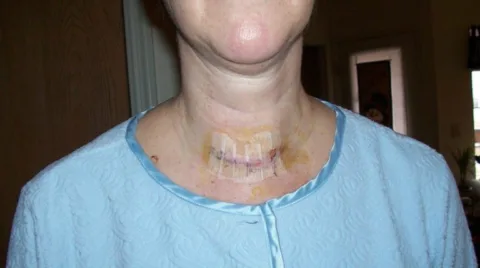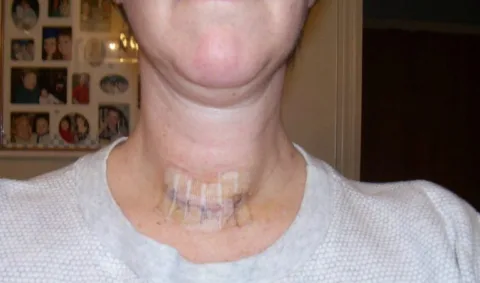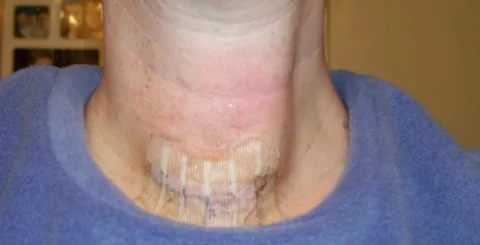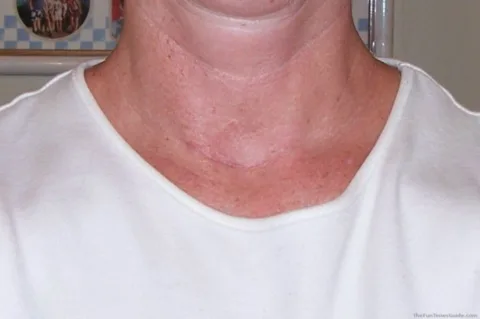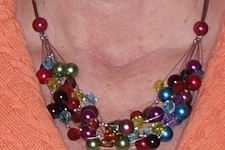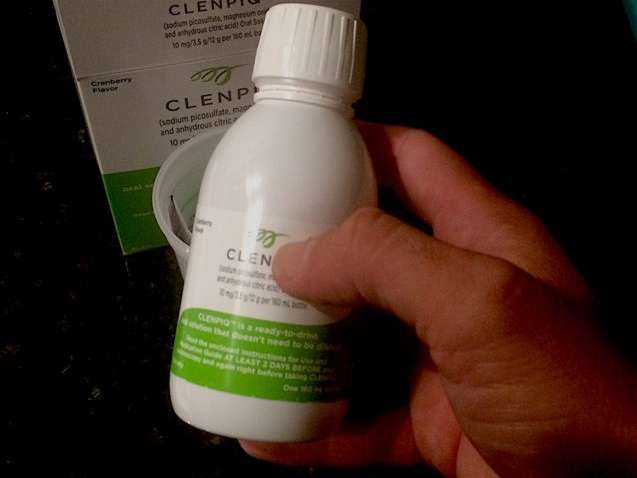My thyroid surgery went well and according to plan — but there are some things I wish I knew ahead of time that would have made my thyroid surgery recovery time even easier.
Surgery began around 9 a.m. on a Friday, and I was home at about 3:30 p.m. that same day.
My surgeon reported to my mom that he was pleased with how it had gone, and he gave her some take-home instructions.
I was actually in more pain than I had expected (or hoped for). In the recovery room, they asked me to rate my pain on a scale from 1 to 10 and my answer was “8”.
They asked if I wanted something for the pain and I remember thinking in my just-out-of-anesthesia haze, “Uh… Hello… Do you even have to ask?… I said EIGHT!”
Before I left the recovery room, the pain was down to 5. I also had a shot of pain medication right before I left the hospital. At home, I had Vicodin every 4 hours for the first 2 days.
Here’s what it was like for me post thyroid surgery (half of my thyroid was removed).
I’ve included some helpful tips to speed up your thyroid surgery recovery time, some things I wish I’d known ahead of time, and my thyroid surgery scar photos for 1 full year after the operation.
What The First 5 Days Were Like
Actually, getting the pain pills down was a bit tricky — because swallowing was a complete bummer, thanks to the double-whammy of:
- Having a tube stuck down my throat during surgery.
- The fact that it was surgery on the neck itself.
So I crushed up my pills at first, and mixed them in some pudding. But that didn’t really work. So I tried cutting up the pills instead. But even in small pieces I was afraid I would choke. Somehow I managed, but it was still scary. Thankfully, that got better each time.
Here’s what the first 2 days of recovery at home were like:
- I had to sleep on my back for the first couple of days.
- I spent most of the first 2 days of recovery in my recliner with my head propped to either side with a small pillow. (It was one of those u-shaped travel pillows.)
- I used that same pillow when sitting up in my recliner too — because it was difficult to move my head or hold it up without a pillow.
At 3 days post-op, I stopped taking the Vicodin (except at night). And I was able to sleep on my side — as long as I was careful not to twist my neck.
At 5 days post-op, I was feeling a lot of pain in my neck above the incision. It was definitely painful to touch my neck, and it hurt to even tilt my head back. It felt like extremely sore muscles.
Day 5 was also the day that they told me the biopsy they tested was benign (yeah!) — and they assured me that the pain I was experiencing was perfectly normal. (I was feeling the pain more since I had stopped taking the meds as much.)
This picture was taken 5 days after my surgery:
Removing The Thick Gauze Bandage Pad
The surgical strips were supposed to come off by themselves 7 to 10 days post-op. (It’s hard to believe there were no stitches, just that tape.)
By the way, the incision was originally covered by a thick gauze pad. They said (when they discharged me) to take that off the day after surgery. That wasn’t fun!
The day after surgery, my first thought was, “I don’t want to take off that pad. It’s nice protection.” Then I realized that I should take it off before the nurse called to check on me later that day — in case I had any questions for her.
Here’s what happened when I removed the bandage:
- I was in the bathroom and I wanted to see if the tape would hurt when I tugged it off.
- I started to gently pull it off. It didn’t hurt, so I continued.
- I could see the first part of the incision, and it didn’t look too bad — so I continued.
- I got to the other end, and it had bled a little and stuck to the pad. But I pulled it off carefully — and since it didn’t hurt, I continued and got the pad all the way off.
Immediately, I felt a “whoosh” — which must’ve been all the blood leaving my head, because I was sure I was going to pass out! I took 2 steps to the bathroom door and realized, “Yep, I’m really going to pass out.” So I leaned against the door for I don’t know how long.
I must’ve nodded out for a few seconds, because when I came to, my hands were shaking and I couldn’t remember why I was there. Then my legs went out and I went down — knocking my eyeball into the door handle. (I should’ve had a black eye but thankfully didn’t!)
So now I’m on the floor, and I managed to get the door open. I crawled to the end of the hallway where my mom (who was visiting to help during the first days after surgery) checks me over to make sure I didn’t break open the incision (I didn’t) or do something obvious to my eye (again, no).
Then she says, “They told me I was supposed to help you take that off.” Well, no one told me that!
So that was an interesting, but brief, post-surgery freak out.
The main takeaway here: Don’t remove your bandages after thyroid surgery alone!
Removing The Sticky Residue Left Behind
And now for a post-surgery pet peeve of mine.
At home, I discovered 2 of the little pads they put on you (to hook you up to the heart monitors and stuff). You know, the kind with the little metal nodes on them?
Well, those (and the big bandage that I took off my neck) left that sticky tape residue on my skin. It’s nearly impossible to get that off — and those sticky spots got gunky and dirty.
I spent a lot of time peeling the stickiness off my body in the days after surgery. I wanted to use my GooGone, but I couldn’t peel it off my neck because it would hurt!
So when I did talk to a nurse, they said “No, it won’t come off with soap and water. You’ll have to use rubbing alcohol.” Also, the same is true for removing the yellow Betadine from your skin.
Now why couldn’t they have told me that ahead of time? And wouldn’t it be nice if they could send a small bit of it home with you?
That’s one of the little things that could make the post thyroid surgery process a bit better, if you ask me.
Here are some step-by-step tips for removing adhesive from your skin.
How Many Days Off Work?
They told me I could go back to work basically as soon as I could drive — but that I should plan on being out of work a week or so.
My initial plan was to go back to work at 5 days post-op, and I could’ve if I had to — but I really wasn’t ready.
I felt I could drive if I had to, but I would’ve been worried about turning my neck. Not to mention the fact that it would have been really uncomfortable all day at work.
I took a full week off from work — actually went back to work the 10th day after surgery.
I was still feeling tired, and I was concerned about the amount of talking I’d be able to do. (A phone call of more than 30 minutes caused my throat to throb.)
1 To 3 Weeks Post-Op: What You Can Expect
At 7 days post-op, this picture was taken:
A 7 full days after thyroid surgery, I could honestly say:
- The pain was much better!
- I still didn’t have complete mobility of my head in all directions, but I felt good enough to drive.
- I still had pain in my neck — whenever I moved it or touched it.
At 10 days post-op, I returned to work. Returning to work after 10 days seemed completely probable — turns out it was too soon for me.
I had no idea how much you move your head and neck when other people are around you — versus just me at home by myself not looking at anything!
After 2 days at work, my neck and shoulder muscles were all tensed up and sore.
I spoke to my doctor’s nurse who agreed that taking the rest of the week off would be a good idea (and would give me another weekend to recover).
At 15 days post-op, this picture was taken:
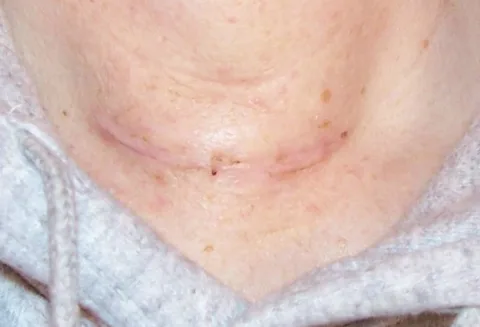
The surgical strips finally came off (with a little help from me — they were barely holding on at that point).
The thyroid scar itself looked pretty good, and it felt much better after a gentle washing in the shower and cleaning up with the rubbing alcohol.
At 17 days post-op, I went back to work for real. I could really feel a big difference in my pain and mobility from the 1st week to the 2nd.
My doctor saw me on this day as well — he said it was healing perfectly.
I did feel a “thickness” surrounding the actual line of incision. I’m not sure what it was exactly, but the doctor said it would go away in about another month.
Here is some typical recovery info following thyroid surgery.
1 Month Post-Op: What You Can Expect
 At the 1 month mark after thyroid surgery, things were healing nicely.
At the 1 month mark after thyroid surgery, things were healing nicely.
Here’s a picture of my whole face — since all along you’ve only seen my neck!
Please remember, it’s weird to take a picture of yourself, and my hair is doing a “dippity don’t”.
My thyroid scar healed very well, and my doctor thought so too. He said everything was good and normal.
A few things I noticed at the 1-month mark:
- Above and below my scar were “ridges.” I can only describe the area as “thick”. But it had decreased drastically from what it felt like initially — so it was clear that the ridges and thickness would disappear over time.
- I could feel the thickness inside too. The doctor said it was just the internal healing.
My doctor-recommended Mederma Skin Care For Scars Soothing Gel. It’s really soothing and definitely helps the healing process! If you’ve never used it, it feels and looks like Neosporin
but it dries a little thicker — almost like it’s creating a waterproof shield or something. It’s difficult to rinse off. Regular washing doesn’t do it. I basically just waited for it to flake off. I rubbed Mederma into my incision 2 to 3 times a day, per the instructions.
TIP: One time during the healing process I wanted to get all the old build-up of Mederma off my neck — so I rubbed it vigorously. BIG MISTAKE. Don’t do this! Man, did it hurt.
As for everyday pain, my scar was still tender — both to the touch and just when I moved my head. Parts of the scar didn’t hurt at all, and a couple of other spots did. It was all quite bearable — just more tenderness than I was expecting at 1 month after the surgery. But since I had seen everything continue to improve, I wasn’t worried.
I was able to move my neck as far as I could before in all directions — I just had to do it slowly. A quick jerk or flinch wasn’t good. So just imagine how much I loved sneezing! Or the one time my sister’s parrot flew at me and I had to duck!
The other post thyroid surgery thing I wasn’t expecting is what my doctor called “voice fatigue.”
Research indicates that voice disturbances occur at least temporarily in up to 80% of patients after they undergo thyroid surgery. About 10% of patients experience voice disturbance directly due to (usually) temporary and (rarely) permanent laryngeal nerve injuries after surgery, with some experiencing voice problems that last for a long time after the procedure. Source
My voice sounded normal to others, and mostly to me too, but it felt like I was on the verge of being hoarse all the time. And after a regular day in the office (I work in customer service at a university — talking all day), my throat felt sore.
I’m not sure how loud or strong it would’ve felt if I had to yell or shout just 1 month after surgery. But I do remember some days I would come home from work, turn OFF the phone (so I didn’t have to talk anymore) and put ON the ice pack (because it still felt good to ice it).
I also had to carry a stick of sunscreen around for awhile. I could feel the sun burning my scar through my car window shortly after surgery — so I was careful to use sunscreen every day while it healed.
Well, thanks for reading my little thyroid story. I hope my experience and the photos help you or someone you know who’s having thyroid surgery.
I would also encourage you to check out the Thyroid Cancer Blog, from a thyroid cancer survivor!
At 3 months post-op, here’s a picture showing what my neck looked like:
At 1 year post-op, here’s what my neck looked like:
More About Thyroid Surgery
In addition to the links I’ve included above, here are some more resources to give you a better idea of what to expect after thyroid surgery:

